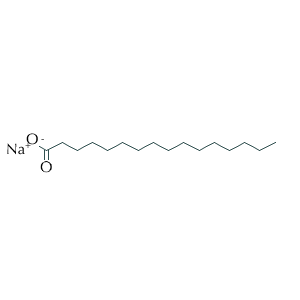What Is Sodium Palmitate?
Sodium palmitate is a skincare and cosmetic ingredient used to saponify oils and fats to create soaps. Sodium palmitate is derived from palm oil however it can also be created synthetically, reducing the environmental impact of the ingredient.
Sodium palmitate is used to saponify oils and fats to create soap. Saponification occurs when fatty acids are reacted with an alkaline ingredient, such as lye. This allows the oils and fats to foam and bubble without leaving oily residue on the skin. Palm oil is often used as a fat or oil in this process and when reacted with lye it creates glycerol and sodium palmitate as by products.

Sodium Palmitate
the good: Sodium palmitate is an ingredient that is created as part of the soap making process. It acts as a surfactant and cleansing ingredient, helping to lift oils and dirt from the skin allowing them to be washed away.
the not so good: As sodium palmitate is derived from palm oil, there are some environmental impacts that need to be considered.
Who is it for? All skin types except those that have an identified allergy to it.
Synergetic ingredients: Works well with most ingredients.
Keep an eye on: Nothing to keep an eye on here.
Why Is Sodium Palmitate Used?
Sodium palmitate is mainly used as a surfactant. Surfactants help to break down the surface tension between two liquids allowing for a deeper clean. The breakdown in surface tension allows for dirt and oils to be lifted from the skin and washed away. This is why sodium palmitate is often found in soaps and some other cleansing products.
Sodium palmitate also helps to emulsify other ingredients. Emulsifiers help to keep a formulation from splitting. When you mix oil and water based ingredients they have a tendency to separate and split. This is because, as the adage says ‘water and oil don’t mix’. This presents an issue for formulators who want to include the benefits of both water-based ingredients and oil-based ingredients. This is where emulsifiers like sodium palmitate come in handy. Emulsifiers help to keep the two types of ingredients mixed together, preventing splitting. This gives you a stable product that will last.
Is Sodium Palmitate Bad For The Environment?
As you probably already know, palm oil has a significant impact on the environment. Palm oil harvesting contributes to deforestation, threatening biodiversity and wildlife such as orangutans and perpetuates poverty in areas where locals have lost their land rights. This type of environmental destruction can occur with any naturally-grown ingredient, as the crops are often grown in low-income areas and demand dictates the need for land to grow the ingredient. However, as palm oil is so widely used in both foods and in skincare, cosmetics and soaps, the demand has significantly strained the environment and local communities where it is grown.
Given that sodium palmitate is derived from palm oil there is a potential that this ingredient is contributing to this impact. However, there are groups working with local communities to create sustainable harvesting practices. Make sure to check if your product’s source of palm oil is sustainably harvested.
Is Sodium Palmitate Vegan?
Sodium palmitate is, by itself, a vegan ingredient. However, it can be combined with animal fats and beeswax when used in the production of soaps. If you are looking for a vegan product, ensure that it is a plant based fat such as coconut oil that they are using to make the soap-based product.
It is also good to keep in mind that not all products that are free from animal-based ingredients are cruelty free. So always check that the brand is a cruelty free brand as well as vegan if you are looking for vegan personal care products.
Is Sodium Palmitate Safe?
The safety of sodium palmitate has been reviewed by the Cosmetic Ingredient Review Expert Panel, a group responsible for evaluating the safety and efficacy of skincare and cosmetic ingredients.
The Expert Panel indicated that sodium palmitate is considered to be safe in its current uses and concentrations when formulated to be non-irritating. It can be drying to some skin types, depending on concentration and the other ingredients in the formulation.







